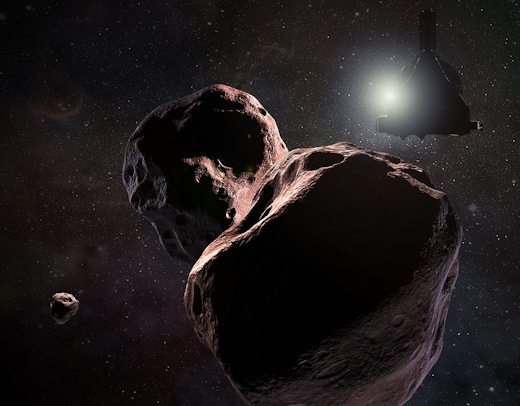Dec. 31, 2018: When NASA’s New Horizons spacecraft flew past Pluto three years ago, mission scientists watching the first close-up images were shocked. Despite being stuck in the deep freeze of the Solar System 6 billion km from the sun, Pluto was not the frozen-stiff world many expected it to be. The geography of the dethroned 9th planet was alive with mountain ranges, windswept dunes, bladed terrain and much more. In one quick flyby, New Horizons turned planetary science on its head.
Get ready to be shocked again. New Horizons is just hours away from a new world even more mysterious than Pluto.

Above: A speculative artist’s concept of Ultima Thule with a small moon
Its name is “Ultima Thule” (2014 MU69), which means means “beyond the borders of the known world.” Indeed, the little space rock is profoundly unknown. Located almost a billion kilometers farther from the sun than Pluto, Ultima Thule has never been much more than a faint speck of light in telescopes. It inhabits the distant Kuiper Belt where, seemingly, almost anything is possible.
“Really, we have no idea what to expect,” says New Horizons principal investigator Alan Stern, of the Southwest Research Institute. “Will it have an atmosphere? Will it have rings? Will it have moons? Any of that could be possible, and soon we’ll know the answers.”
On New Year’s Eve and New Year’s Day, New Horizons will swoop three times closer to Ultima Thule than it flew past Pluto in July 2015, shattering previous records for the most distant body explored by a human spacecraft. First images will be posted on a web site set up by the New Horizons’ team: SeeUltimaThuleNow.com
We already know one thing about Ultima Thule. Its shape is elongated and strange. In 2017, astronomers watched a distant star pass behind Ultima Thule. Starlight winked in and out in a pattern suggesting two lobes with diameters of 20 and 18 km, respectively. Ultima Thule could be a small binary system.
“Ultima Thule is 100 times smaller than Pluto, but its scientific value is incalculable,” says Stern. “From everything we know, it was formed 4.5 or 4.6 billion years ago, 4 billion miles from the sun. It has been stored at that enormous distance from the sun, at a temperature of nearly absolute zero, ever since, so it likely represents the best sample of the ancient solar nebula ever studied.”
“Nothing like it has ever been explored,” he says.
